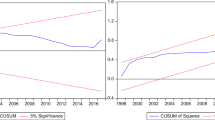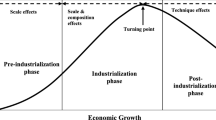Abstract
This paper examines the effect of trade openness on deforestation for environmental quality in Nigeria. Autoregressive Distributed Lag bounds testing approach to cointegration was used to achieved the long-run equilibrium relationship among the variables. Economic growth, energy consumption and population were used as control variable. The long-run result shows that the coefficients of trade openness and economic growth are significant and inversely related to deforestation. This suggests that trade openness and growth reduce deforestation and improves environmental quality. Conversely, the long-run coefficient of population is significant and positively related to deforestation, meaning that population increases deforestation and environmental degradation. However, the long-run result for energy consumption did not produce statistical significance. Furthermore, all the short-run results were consistent with their long-run result.



Similar content being viewed by others
References
Ahmed, K., Shahbaz, M., Qasim, A., & Long, W. (2015). The linkages between deforestation, energy and growth for environmental degradation in Pakistan. Ecological Indicators, 49, 95–103.
Bello, A. K., & Abimbola, O. M. (2010). Does the level of economic growth influence environmental quality in Nigeria: A test of environmental Kuznets curve (EKC) hypothesis? Pakistan Journal of Social Sciences, 7, 325–329.
Brown, R. L., Durbin, J., & Evans, J. M. (1975). Techniques for testing the constancy of regression relations over time. Journal of the Royal Statistical Society, Series B, 37, 149–163.
Choumert, J., Combes Motel, P., & Dakpo, H. K. (2013). Is the Environmental Kuznets Curve for deforestation a threatened theory? A meta-analysis of the literature. Ecological Economics, 90, 19–28.
Culas, R. J. (2007). Deforestation and the environmental Kuznets curve: An institutional perspective. Ecological Economics, 61(2–3), 429–437.
Epule, E. T., Peng, C., Lepage, L., & Chen, Z. (2014). Policy options towards deforestation reduction in Cameroon: An analysis based on a systematic approach. Land Use Policy, 36, 405–415.
FAO. (2014). Food and agricultural organization of United nations: Available at http://www.fao.org/home/en/.
Geist, H. J., & Lambin, E. F. (2001). What drives tropical deforestation? A meta-analysis of proximate and underlying causes of deforestation based on subnational case study evidence. Available at: http://www.pik-potsdam.de/members/cramer/teaching/0607/Geist_2001_LUCC_Report.pdf.
Grossman, G., & Krueger, A. (1995). Economic growth and the environment. Quarterly Journal of Economics, 110(2), 352–377.
Halicioglu, F. (2009). An econometric study of CO2 emissions, energy consumption, income and foreign trade in Turkey. Energy Policy, 37(3), 1156–1164.
IPCC. (2007). Intergovernmental panel on climate change. Available at http://www.ipcc.ch.
Jalil, A., & Feridun, M. (2011). The impact of growth, energy and financial development on the environment in China: A cointegration analysis. Energy Economics, 33(2), 284–291.
Kuznets, S. (1955). Economic growth and income inequality. The American Economic Review, 45, 1–28.
Narayan, P. K. (2005). The saving and investment nexus for China: Evidence from cointegration tests. Applied Economics, 37(17), 1979–1990.
Pesaran, M. H., Shin, Y., & Smith, R. J. (2001). Bounds testing approaches to the analysis of level relationships. Journal of Applied Econometrics, 16(3), 289–326.
Scrieciu, S. S. (2007). Can economic causes of tropical deforestation be identified at a global level? Ecological Economics, 62(3–4), 603–612.
Shahbaz, M., Mutascu, M., & Azim, P. (2013). Environmental Kuznets curve in Romania and the role of energy consumption. Renewable and Sustainable Energy Reviews, 18(January 2007), 165–173.
Shahbaz, M., Solarin, S. A., Mahmood, H., & Arouri, M. (2013b). Does financial development reduce CO2 emissions in Malaysian economy? A time series analysis. Economic Modelling, 35, 145–152.
Stern, N. (2006). Review on the economics of climate change. London: HM Treasury.
UNFCCC. (2014). United Nations framework convention on climate change. Available at http://unfccc.int.
WDI. (2015). World Bank’s world development indicators. Available at www.worldbank.org.
Author information
Authors and Affiliations
Corresponding author
Rights and permissions
About this article
Cite this article
Maji, I.K. The link between trade openness and deforestation for environmental quality in Nigeria. GeoJournal 82, 131–138 (2017). https://doi.org/10.1007/s10708-015-9678-7
Published:
Issue Date:
DOI: https://doi.org/10.1007/s10708-015-9678-7




